Home | Front Page | Blog | Index | New | Contact | Site Map
![]() Japan
Japan
![]() Nagoya
Nagoya
![]() Takayama
Takayama
![]() Gifu
Gifu
![]() Kanazawa
Kanazawa
![]() Kyoto
Kyoto
![]() Shikoku
Shikoku
![]() Henro Pilgrimage
Henro Pilgrimage
Cherry Blossoms
Shrines and Temples
Museums
Bicycling
Kabuki Theater
Food and Lodging
Shibuya
Shinjuku
Yokohama
Narita Town

Travel 2008
Australia
Britain
Paris
Basel
Berlin
Travel 2007
Sydney
Paris
Britain
USA
Canada
Australia 2007-08
Travel 2006
Greece
Turkey
Thailand
Malaysia
Indonesia
Singapore
Travel 2005
Berlin
Paris
Moscow
Russia
Athens
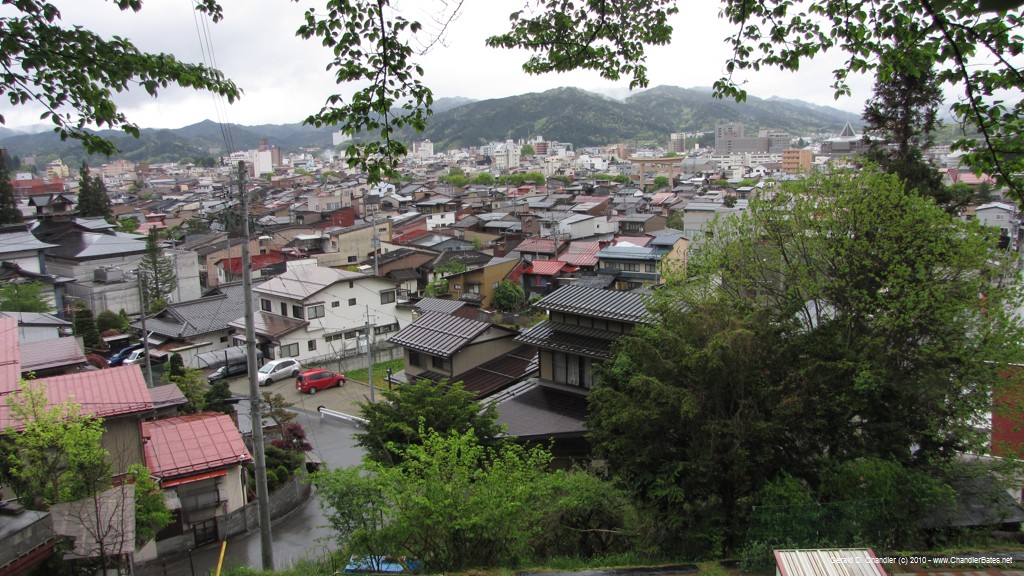
Takayama Today |
We don't know where to start in describing Takayama so we may as well begin with saying we liked it. Depending on your perspective it's in the Japanese alps or is the gateway to them. The name means high mountain. When we arrived, a week after leaving Tokyo, it was immediately obvious that we were higher and colder. It was like a time warp, in that in lower Tokyo and Nagoya the cherry blossoms were long gone. Here there were remnants, past their prime, but still capable of giving an idea of what the glory had been.
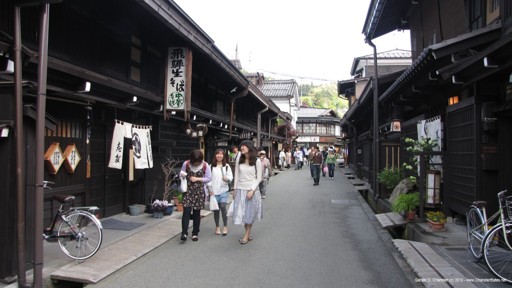
Preserved Takayama Street |
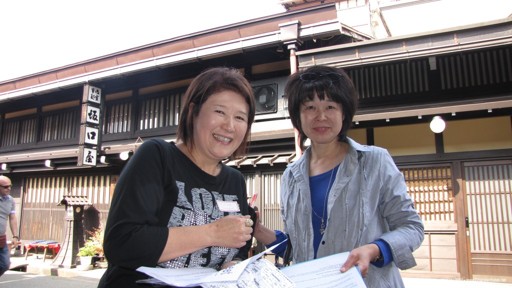
Nagoya English Students |
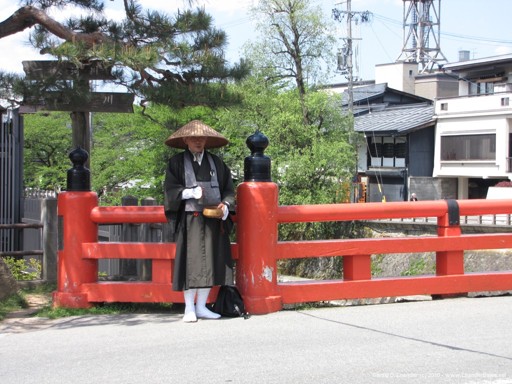
Henro Pilgrim Seeking alms? |
The town is somewhat small and very definitely a tourist destination. Busloads of Japanese tourists arrive from Nagoya and even Kyoto on weekends for a taste of mountain air, to visit the temples, and to be in the relatively unspoiled and traditional small town that Takayama is. Most head directly to the four or five streets that are preserved (or more likely, recreated) traditional streets — all wood fronts and single storied-buildings. That's what we did in the afternoon of our first day after our arival from Nagoya and the stowing of our bags at our hostel.
We were relaxing on a bench on one of these streets when we were approached by two Japanese students of English: Would we answer their questionaire? It was an opportunity for us as much as them: we asked who they were and why they'd approached us. They'd come from Nagoya — just as we had — but only for the day. Their teacher had given them a questionnaire and told them to go look for foreigners to practice English with while getting them to fill out the questionnaire. We must have been either the only English-speaking foreigners around, or the only ones with patience enough to deal with these people. After saying goodbye to them another and then another pair or triplet or quadruple approached us. Ultimately we were approached by almost the whole busload in one short afternoon wandering the main tourist street.

Zenkoji Entrance |
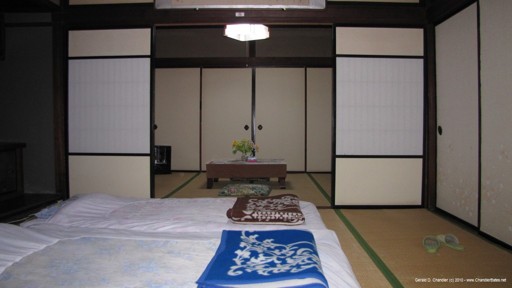
Zenkoji Tatami Room |
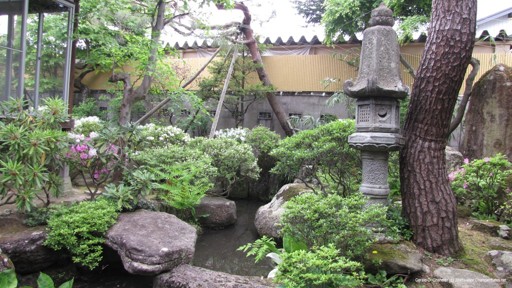
Zenkoji Garden |
We spent a whole week in Takayama and stayed in our most interesting accommodations for a long time. We were in the Zenkoji backpacker hostel which is housed in a Buddhist temple. It was a bit of a rabbit-warren, but we had booked via the internet before leaving Tokyo and had been promised a very nice room by the young woman who booked us in. The room was indeed very nice. In fact it was two rooms, both tatami, separated by paper-thin sliding doors. Both were spacious, one overlooking a lovely courtyard and one behind it, that had no direct light. When we arrived the outer room was set up for sleeping, but we quickly moved our futons and pillows and quilts to the inner room. The outer room gave onto a corridor and beyond, through floor to ceiling glass doors, onto a very lovely, enclosed Japanese garden. The Japanese always manage to make a great deal of very little. This garden was no exception. In a space about 20 feet by 50 feet (6x15m), there was a stream stocked with carp, a little waterfall, a wooden bridge, and a myriad of large rocks imitating whatever mountain landscape you desired. We spent quite a lot of time in the room, looking out at the garden while typing away on our computers using the Wi-Fi provided by the hostel. A few times we sat on a garden rock and read, guidebook or novel.

Hie Jinja Temple |
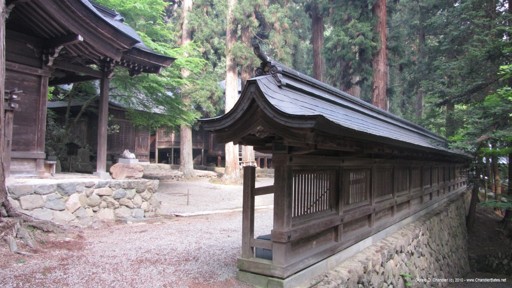
Hie Jinja Temple |
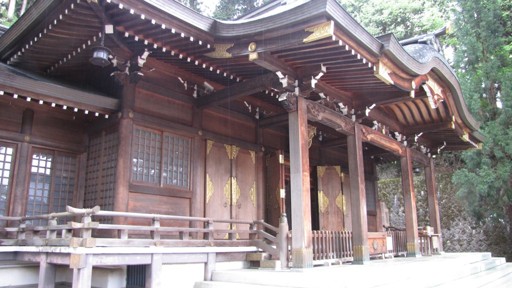
Sakura Shrine |
Takayama is famous not only for its mountainous surroundings, but also for its temples, of which there are dozens and dozens, mostly in two groups on the upper hillsides that define the north-east and south-east sides of Takayama. The tourist office provides a map to them and we trekked through each group, but not end-to-end. As usual, only after making a visit can one really understand the map: On the first group we quit because it was just too far for us. For the second group, which required going over a big hill, we somehow lost the route. The temples are all the same — or at least the same as one New England salt box is to another or all cathedrals are the same. In other words each one is different from all the rest and has something uniquely attractive to it. We started with Higashiyama ("Eastern Hill"). and had some lovely sunny weather to help the project along. We profited from it by finding a shady spot in a temple forecourt to sit down and eat our bento lunch box. On the second round there was a bit of rain, but not much, and we enjoyed the higher views.

Hida No Sato Village |
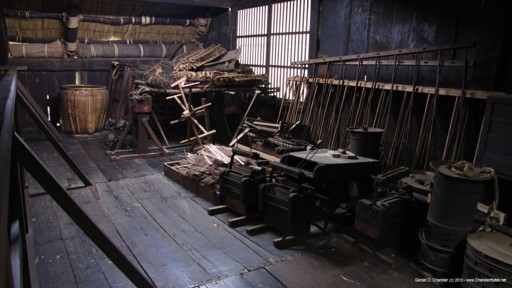
Hida No Sato Village |
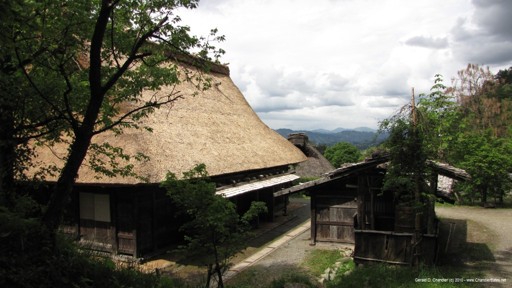
Hida No Sato Village |
The other tourist site that Takayama is famous for is the Hida No Sato Folk Village. Much like the Edo-Tokyo Open Air Architectural Museum, (ETOAAM) the park has collected a large number of traditional Japanese farmhouses and placed them on a hillside around an artificical lake. Most people run through it in a couple of hours. One British guy we heard talking to his wife, couldn't understand why they were spending more than half an hour at the place. We, however, managed a whole day. We tend to see the many ways in which the houses differ rather than dwell on their similarities.

Sukyo Mahikari Temple |
On leaving Hida no Sato, we decided to walk downhill to a huge golden-roofed temple that we had passed on the bus coming into town and had noticed was just below us. It turned out to be quite enormous, and built in 1984 for a new fusion religion called World Vision or Sukyo Mahikari. We managed to get from street level up to about the sixth floor level where we found the main auditorium of the temple. It was sure built to handle the multitudes, but when we were there was almost completely empty. By the time we left we'd had a long day and were very glad there was a bus back into the city so we wouldn't have to walk.
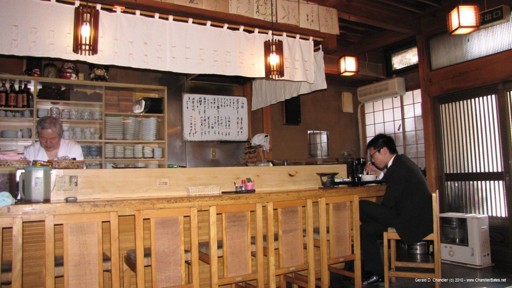
Hashi Zen Restaurant |
The Zenkoji had a pretty well-equipped kitchen and was located just half a block from a pretty good supermarket, so we ate all of our breakfasts in the hostel, and some of our evening meals. But for lunch, we were usually out and about and so either ate our usual lunch box, or had to find a restaurant. On the day we arrived, we asked the monk who greeted us where we could eat for a reasonable price and he recommended a restaurant called Hashi Zen. It was only two blocks away but initially we got confused and stopped into a family run noodle shop that did a roaring trade. Sitting at the counter like most of the other clients, who seemed to us to be students, we were on top of the boiling noodle pots. So we ordered noodles, not knowing what we'd get, and got a delicious meal. We always wanted to go back, but never managed it — probably because we learned to read in Japanese the name Hashi Zen and thus found the recommended restaurant.
We ate at Hashi Zen twice and loved it. It was a very small place, with three low tables on a raised platform that each could seat about six people, and a bar with about six or eight bar stools. The first time there we stopped outside to puzzle over what was obviously the listing of the day's set lunch. It was clear that the price was right (850 yen), that there were choices, and that we didn't know what they were. In we went and ordered the set lunch, which consisted of a tray of steamed white rice, tofu, three or four different pickled vegetables, and a cold egg omelette. As an appetizer we were served a kind of thick fermented soy paste. It was only a small mouthful but was served hot on a little portable burner. We were asked which main dish we wanted and with some help figured out it was either tempura or sashimi. Gerry each time had the tempura and Jan always chose the sashi and both were happy campers.

Mormon-Run English Class |
In Nagoya, before coming to Takayama, we ate a less-fancy meal at the train station McDonalds. (Don't knock it! At McDonalds you are sure to know what you are about to eat.) There we bumped into — actually overheard — two Mormon (Later Day Saints) missionaries in Japan and learned from them they were off to Takayama, where they were doing their work. We told them we were going and they gave us good advice on taking the bus, etc. And since we were going to Takayama would we like to come to their Tuesday night English class and help out? No promises were made, but our first and only Tuesday in Takayama that is what we did. To get there we had to have a catch-as-catch-can meal not even as good as McDonalds, but that was made up for by the comraderie of the English class, where we helped the students (free for them) to practice the model "If you do — then I'll do."
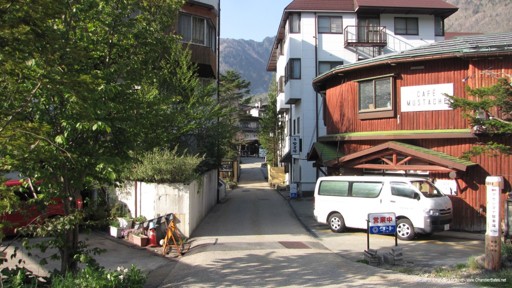
Hirayu Hotel |
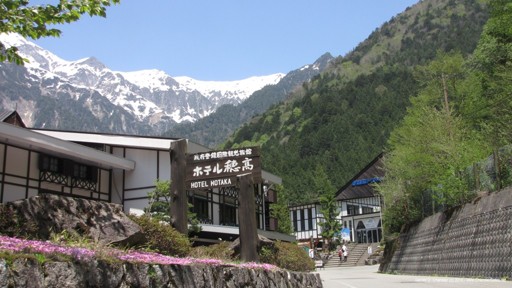
Shinhotaka Hotel |

Ogimachi Farmhouse |
We couldn't be this close to the mountains without making at least one trip to see them. So two days before leaving Takayama we made a day trip to the onsen (hot bath) resort of Hirayu and from there went on to the big cable car at Shinhotaka that takes tourist up to the top of the mountain. The trip to Shinhotaka takes about 1.5 hours and passes through what used to be villages but in the age of the automobile large parts have become a mostly dreary landscape. Hirayu is where the mountains really begin; from there the bus starts to take a less-direct route, stopping at many imposing hotels; in the winter it is the skiers bus.
When we left Takayama we went on to Kanazawa and on the way stopped to see the village of Ogimachi. There are several dozen preserved gassho-zukuri farmhouses, many hundreds of years old. Unlike Hida-no-Sato which also has many gassho houses those of Ogimachi are lived in. A few have become restaurants and the like but, as of now, most are inhabited by local farmers.